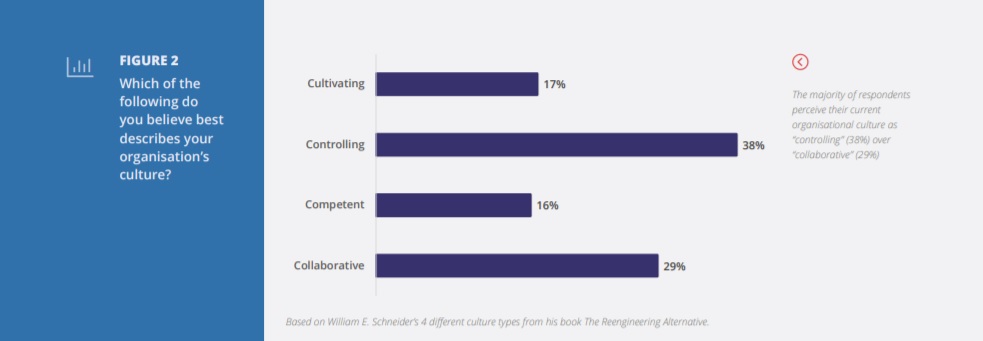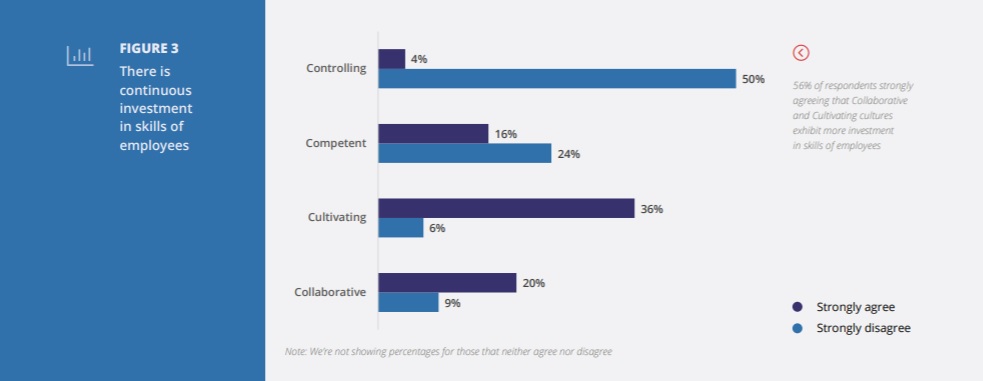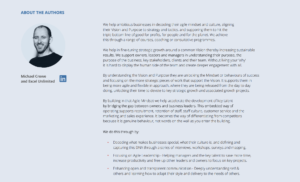We’ve just published the results of our workplace culture research entitled ‘A guide on the importance of building an agile culture’ and you can download it free here.
In it we cover:
- Organisational agility and agile teams in the context of modern management
- Cultural challenges during agile transformations
- How to make Culture work
- Recommendations
The guide talks about the importance of building an agile culture and harnessing the power of people in your organisation to find ways to be more adaptive, innovative and resilient in our fast-paced digital economy.
More companies are looking at implementing agile or changing their culture to be more of an agile culture and what it could mean for their organisation in terms of being more responsive to changing customer behaviour and expectations and internally being more transparent and autonomous.
An agile culture is increasingly recognised as a critical component for the survival and growth of a business. In a fast-paced environment where changing trends and consumer sentiment are the norm, significant disruption is not only to be expected but embraced.
Rapid changes in competition, demand, consumer and employee expectations, technology and regulations make it imperative for organisations to be able to adapt to changing environments and conditions quickly.
In our research, we looked at how SMEs manage change and transformation when they go through a transition, such as a growth phase or through the process of Merger and Acquisition. Our findings centred around four key elements of organisational culture to more efficiently pursue agile transformations.
Those four elements are:
- Recognition: Recognising good or hard/smart work
- Communication: Organisational purpose, clarity of expectations and alignment of people
- Trust: Trust in other people/ Organisation
- Learning: Investment in training and staff development
The majority of business leaders we interviewed agreed that agile was important to their organisation with 30% strongly agreeing. Yet, adopting an agile culture remains the most significant self-reported barrier to digital effectiveness as also confirmed by a recent Gallup poll.
The results from our survey suggest that companies have higher aspirations for agility. Respondents confirmed that agility pays off for their businesses and even those who have not begun agile transformations are planning for either unit-level or company-wide transformations in the near future.
Interviewees across industries also report a desire to scale up agile ways of working.
Cultivating an organisational culture that is more suited to an agile mindset produces higher degrees of trust in company leadership.
49% of respondents feel that there is no clear system for recognising individual efforts and more than 50% considered there is a lack of team’s efforts recognition.
61% of respondents consider it important for their organisations to change their culture to a more agile one.
Of general respondents, only 16% confirmed there was a continuous investment in skills of employees and more than a quarter strongly disagreed saying there wasn’t.
When conducting our research we referred to the four types of culture as outlined by William E. Schneider in his book The Reengineering Alternative. His competing values matrix model defines 4 different culture types as:
- Collaboration,
- Control,
- Cultivation,
- Competence.
No one culture is ‘better’ than another, and companies can have more than one culture, but there is usually a dominant culture, a set of accepted behaviours and it is this that needs to be more agile.

Figure 2
Organisational culture is the way things are done in your company and it is becoming a major priority for business functions. Whatever the type of culture you develop, it must sit at the heart of strategy for today’s businesses. From an agile perspective, depending on the focus of your organisation, your company culture will likely either be:
- People Oriented (Personal) vs. Company Oriented (Impersonal)
- Reality Oriented (Actuality) vs. Possibility Oriented (Achievement)
What do you think yours is?
“ An entrenched controlling culture and the behaviour that drives it can be one of the most destructive and restrictive barriers to change.”
Investment in skills appeared to be at its lowest in controlling cultures.

Figure 3
“ To be agile, an organisation needs to be both dynamic and stable.”
Your culture also has a hand in how your brand, mission and vision is perceived, understood internally and externally and is driven by staff, clients and suppliers. Changes between culture types happen not just within different departments and teams but also due to outside processes, such as a merger & acquisition, branching into multiple locations or due to a digital transformation or innovation initiative.

Figure 10.
A guide on the importance of building an agile culture – download it free here.
If you need help with better understanding your organisational culture or are struggling to understand why processes are so slow or are thinking about building an agile culture then get in touch.
About the authors:


Article by channel:
Everything you need to know about Digital Transformation
The best articles, news and events direct to your inbox









